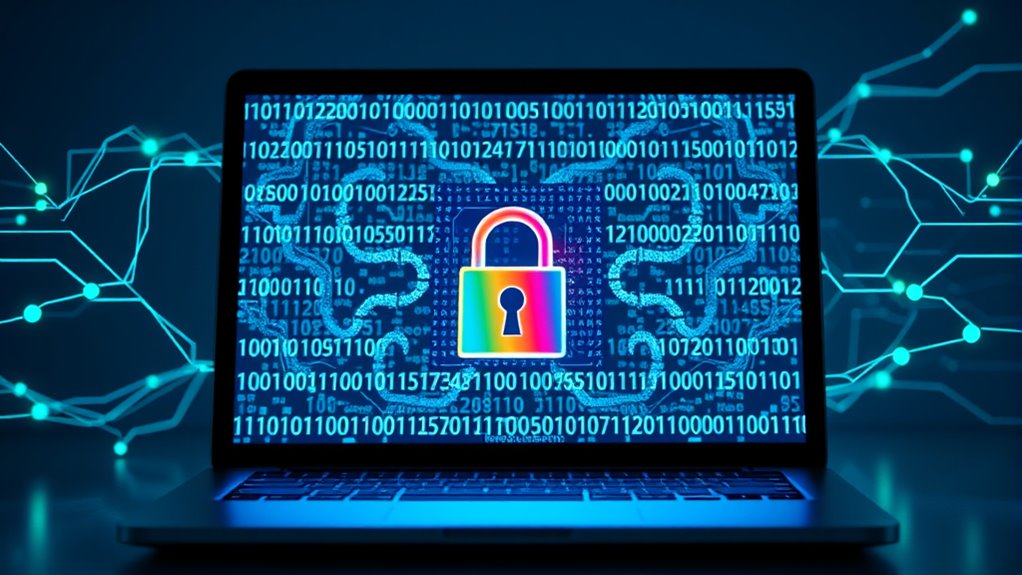Encryption keeps your data safe by converting sensitive information into an unreadable format. This process protects your personal details from unauthorized access during online transactions and communications. It uses cryptographic algorithms, like AES, to scramble your data, ensuring only those with the correct keys can access it. This way, whether your data’s at rest or in transit, it remains secure. Discover how key management and additional security measures further enhance your data protection.
Key Takeaways
- Encryption scrambles sensitive data, making it unreadable to unauthorized users, ensuring confidentiality during online transmission and storage.
- Cryptographic algorithms like AES and RSA encode data into ciphertext, obscuring original information and enhancing security.
- Key management practices protect cryptographic keys, preventing unauthorized access and ensuring the integrity of the encryption system.
- Encryption secures both data at rest on devices and data in transit over networks, maintaining data confidentiality and integrity.
- Using secure protocols like HTTPS further protects data during online activities, preventing interception and ensuring safe communications.

Have you ever wondered how your sensitive data stays safe online? It’s a question that many of us ponder, especially as we share more personal information and conduct transactions over the internet. The answer lies in a powerful technology known as encryption. This process transforms your data into a scrambled format, making it unreadable to unauthorized users. But how does this work, and what role do cryptographic algorithms and key management play in this essential security measure?
At the heart of encryption are cryptographic algorithms, which are mathematical formulas that determine how data is encoded. When you send a message or input sensitive information, these algorithms take your data and convert it into a ciphertext, a format that appears as a random string of characters. This scrambling ensures that even if someone intercepts your data, they won’t be able to decipher it without the proper tools. Different algorithms, such as AES (Advanced Encryption Standard) or RSA (Rivest-Shamir-Adleman), vary in complexity and security level, providing options based on the sensitivity of the information you’re protecting.
Cryptographic algorithms transform your data into ciphertext, ensuring that unauthorized users cannot decipher it without the right tools.
Key management is another critical component of encryption. When your data is encrypted, it’s locked with a specific key—think of it like a password that allows access to the original information. Proper key management guarantees that these keys are generated, stored, and distributed securely. If a key falls into the wrong hands, it can compromise your data. That’s why many organizations invest in sophisticated key management systems, which help keep track of which keys are in use, rotate them regularly, and revoke access when necessary. You wouldn’t want to use the same key forever; doing so increases the risk of unauthorized access.
Moreover, encryption isn’t just about protecting data at rest (like files stored on your device) but also data in transit—like when you send an email or make an online purchase. Using secure protocols like HTTPS ensures that your data remains encrypted as it travels across the internet, safeguarding it from prying eyes. Additionally, color accuracy plays a crucial role in ensuring that digital images transmitted over secure channels maintain their integrity and appearance.
Frequently Asked Questions
What Types of Encryption Are Most Commonly Used Today?
The most commonly used types of encryption today are symmetric and asymmetric encryption. With symmetric encryption, you use a single key to both encrypt and decrypt your data, making it fast but requiring secure key sharing. In contrast, asymmetric encryption utilizes a pair of keys: a public key for encryption and a private key for decryption. This approach enhances security, especially for sharing sensitive information online, as you don’t have to share the private key.
Can Encryption Protect Against All Cyber Threats?
No, encryption can’t protect against all cyber threats. While it secures your data during transmission and storage, it has limitations. For instance, if a hacker gains access to your device, encrypted data can still be compromised. That’s why user awareness is vital; understanding potential risks and practicing safe online habits can greatly reduce vulnerabilities. Always stay informed and vigilant to complement encryption’s protective measures and better safeguard your information.
How Does Encryption Impact System Performance?
Imagine trying to race with a heavy backpack; that’s how encryption affects system performance. While it provides essential security, it introduces encryption overhead, increasing system latency. You’ll notice slower processing speeds, especially if your system handles large amounts of data. However, the trade-off is often worth it, as the protection against cyber threats outweighs the slight performance hit. Balancing security with efficiency is key to maintaining a smooth user experience.
Is Encrypted Data Completely Secure From Hackers?
Encrypted data isn’t completely secure from hackers. While encryption adds a layer of protection, vulnerabilities can still exist, especially if encryption key management isn’t handled properly. In cloud computing, if your keys are compromised or poorly managed, hackers can gain access to your data. So, it’s essential to implement strong key management practices and regularly review your security measures to minimize risks and enhance your overall data protection strategy.
What Happens if I Forget My Encryption Password?
If you forget your encryption password, accessing your data becomes a challenge. Don’t worry too much, though—encryption recovery options can help, but they often require prior setup. You should consider using a reliable password management tool that securely stores your passwords and recovery keys. Visualize this as a safety net for your data; it keeps your information accessible even in tricky situations. Just remember, proactive management is key to avoiding frustration later!
Conclusion
In a world where your data’s worth is like gold, encryption acts as your sturdy vault, keeping it safe from prying eyes. By scrambling your information, it guarantees only those with the right keys can access it. So, whether you’re shopping online or sharing personal messages, remember that encryption is your shield against potential threats. Embrace it, and take control of your digital safety—because in the vast ocean of the internet, you deserve a lifeboat.










